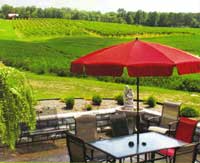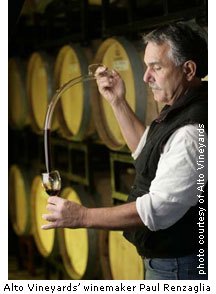

Honker Hill Winery in Shawnee Hills is one of the highest elevations in southern Illinois
Ilinois hybrids challenged by Cabernet Franc
Like most cold climate states, Illinois has long used French and American hybrid grapes to beat the tough winter months. Chambourcin and Traminette have been trusted for good wines of the region, but the Shawnee Hills in southern Illinois is now showing Cabernet Franc can not only thrive, but produce outstanding wines.
by
Bill Shoemaker
April 13, 2012
The state of Illinois is very long, north-to-south, resulting in broad diversity of wine grape growing regions. A combination of weather and soils are at play yet it is the winter months that present the real issues to vinifera. French and American hybrid wine grapes have been the historical players in most regions of the State as a result. Cabernet Franc is now challenging and changing that in the Shawnee Hills.
In recent years, efforts to develop vinifera production in the deep south, especially in the Shawnee Hills AVA, Illinois only fully in-state AVA, have been surprisingly successful. Cabernet Franc, which is considered one of the most cold hardy of vinifera, is now being grown by a number of growers in this region, some of whom sell to northern Illinois wineries. But, most remain quite invested in quality hybrids.

As you go north into central Illinois, pockets of grape production and retail wineries, particularly along the river valleys and the downstate small cities exist, but these are not major areas for production. Again it is hybrid cultivation that dominates this region.
Moving to northern Illinois, the NW region around Galena, is part of the vast, multi-state, Upper Mississippi River Valley AVA. The terrain there is excellent for grapes, but it becomes bitter cold during winter months. There, temperatures render vinifera futile to cultivate so these vineyards rely heavily on varieties with super cold hardiness, such as Marechal Foch, Frontenac, St Pepin and, the new comer, Marquette.
Significant development of both vineyards and wineries are also, now, emerging around the perimeter of the Chicago metro area. These are urban proximate market-driven enterprises. The vineyards are located by convenience and the wineries are focused on tapping into the Chicago area population. There players also have some ability to realize higher pricing as a result of this position, than wines of southern Illinois.
All of the northern wineries buy fruit from southern Illinois growers because those vineyards are larger, the growers have more experience and because, simply, not enough fruit is grown in northern Illinois to serve the production demand.
Chambourcin and Traminette are doing well in the bottle. Alto Vineyards in the Shawnee Hills has won the Jefferson Cup twice by virtue of those two grapes. But other wineries are making very nice wines with them as well.

The grape causing the most stir right now is Cabernet Franc. It is being vinified by wineries in the north and the south. Blue Sky Winery has had very good success with it in the Shawnee Hills as an estate grown wine. Prairie State Winery in northern Illinois has won the Governor's Cup in the Illinois state wine competition two years running for their version of Cabernet Franc made from southern Illinois Grapes. Their 2009 Cabernet Franc is really a very nice representation of the grape.
It is interesting, the more discovered about the Shawnee Hills appellation, the more it looks like the Virginia industry. We'll have to see if it continues to do so. Visitation to tasting rooms is more often the surest way to explore the diversity of Illinois wines. Shawnee Hills Wine Trails provides a good resource for their AVA visitation.










 READER FEEDBACK: To post your comments on this story,
READER FEEDBACK: To post your comments on this story,


